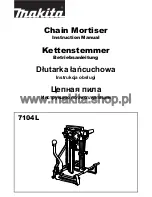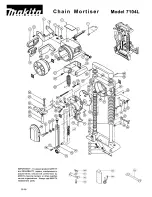
OPERATION
OPERATING THE SAW
See Figure 5.
Follow these directions to operate the saw.
Secure the workpiece to a work bench or table with a
vise or with clamps.
Make sure the saw blade is clear of any foreign material
and that the power cord and extension cord are out of
the blade path.
Hold the saw firmly in front of and clearly away from you.
Mark the line of cut clearly.
Depress the trigger switch to start the cutting action.
Set the base assembly against the workpiece.
Move the blade into the workpiece.
NOTE: Do not force. Use only enough pressure to keep
the saw cutting. Let the blade and saw do the work. Keep
pressure on the base, against the workpiece.
PLUNGE CUTTING
See Figure 6.
Follow these directions to plunge cut.
Secure the workpiece to a work bench or table with a
vise or with clamps.
Make sure the saw blade is clear of any foreign material
and that the power cord and extension cord are out of
the blade path.
Hold the saw firmly in front of and clearly away from you.
Mark the line of cut clearly.
Choose a convenient starting point inside the cutting area
and place the tip of the blade over that point.
Rest the front edge of the shoe assembly on the workpiece
and hold it firmly in position during the cut.
Depress the trigger switch and allow the saw blade to
reach full cutting speed.
Tilt the saw downward until the tip of the blade starts
cutting the workpiece.
Allow the saw to penetrate the workpiece.
Tilt the saw until the blade is perpendicular to the
workpiece.
WARNING: Make sure the blade does not
touch the workpiece until the motor reaches
full speed. Faillure to heed this warning can
cause you to lose of control of the saw and
result in serious injury.
WARNING: Blades longer than 15.2 cm can
whip and should not be used for plunge
cutting. Failure to heed this warning can
resut in serious personal injury.
WARNING: Cutting into electrical wiring can
cause the blade, the blade clamp, and the
saw bar assembly to become electrically
live.Do not touch metal parts when cutting
into a wall; grasp only the insulated surfaces
on the tool. Make sure hidden electrical
wiring, water pipes, and mechanical hazards
are not in the blade path when cutting into
a wall.
Fig 5.
Fig 6.

























